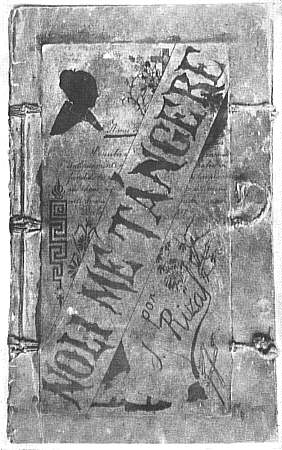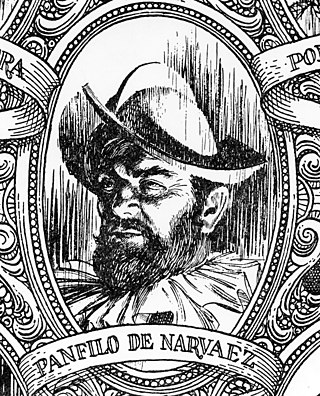
Noli Me Tángere is a novel by Filipino writer and activist José Rizal and was published during the Spanish colonial period of the Philippines. It explores perceived inequities in law and practice in terms of the treatment by the ruling government and the Spanish Catholic friars of the resident peoples in the late-19th century.

Álvar Núñez Cabeza de Vaca was a Spanish explorer of the New World, and one of four survivors of the 1527 Narváez expedition. During eight years of traveling across what is now the US Southwest, he became a trader and faith healer to various Native American tribes before reconnecting with Spanish civilization in Mexico in 1536. After returning to Spain in 1537, he wrote an account, first published in 1542 as La relación y comentarios, which in later editions was retitled Naufragios y comentarios. Cabeza de Vaca is sometimes considered a proto-anthropologist for his detailed accounts of the many tribes of Native Americans that he encountered.

Pánfilo de Narváez was a Spanish conquistador and soldier in the Americas. Born in Spain, he first sailed to the island of Jamaica in 1510 as a soldier. Pánfilo participated in the conquest of Cuba and led an expedition to Camagüey, escorting Bartolomé de las Casas.

The Narváez expedition was a Spanish expedition started in 1527 that was intended to explore Florida and establish colonial settlements. The expedition was initially led by Pánfilo de Narváez, who died in 1528. Many more people died as the expedition traveled west along the explored Gulf Coast of the present-day United States and into the American southwest. Only four of the expedition's original members survived, reaching Mexico City in 1536. These survivors were the first known non-Native Americans to see the Mississippi River, and to cross the Gulf of Mexico and Texas.

El filibusterismo, also known by its alternative English title The Reign of Greed, is the second novel written by Philippine national hero José Rizal. It is the sequel to Noli Me Tángere and, like the first book, was written in Spanish. It was first published in 1891 in Ghent.
Estevanico, also known as Esteban de Dorantes and Estevanico the Moor, was the first person of African descent to explore North America. Little is known about his background but contemporary accounts described him as a "negro alárabe" or "Arabic-speaking black man" native to Azemmour, Morocco. In 1522, he was sold as a slave to the Spanish nobleman Andrés Dorantes de Carranza in the Portuguese-controlled Moroccan town of Azemmour.
Marcos de Niza, OFM was a Franciscan friar and missionary from the city of Nice in the Duchy of Savoy. Marcos led the first Spanish expedition to explore what is now the American Southwest. His report of finding a "beautiful city", "more extensive than that of Mexico [City]", induced Viceroy Antonio de Mendoza to organize a large-scale entrada under the leadership of Francisco Vázquez de Coronado. Marcos served as a guide for this expedition but when they failed to find the wealth they expected, Coronado blamed Marcos, called him a liar and sent the friar back to Mexico in disgrace.

Ilan Stavans is an American writer and academic. He writes and speaks on American, Hispanic, and Jewish cultures. He is the author of Quixote (2015) and a contributor to the Norton Anthology of Latino Literature (2010). He was the host of the syndicated PBS show Conversations with Ilan Stavans, which ran from 2001 to 2006.
Cabeza de Vaca is a 1991 Mexican film about the adventures of Álvar Núñez Cabeza de Vaca, an early Spanish explorer, as he traversed what later became the American South. He was one of four survivors of the Narváez expedition and shipwreck. He became known as a shaman among the Native American tribes he encountered, which helped him survive. His journey of a number of years began in 1528. After his return to Spain, he published his journal in 1542. The screenplay by Guillermo Sheridan and Nicolás Echevarría is based on this journal.

Mexican American literature is literature written by Mexican Americans in the United States. Although its origins can be traced back to the sixteenth century, the bulk of Mexican American literature dates from post-1848 and the United States annexation of large parts of Mexico in the wake of the Mexican–American War. Today, as a part of American literature in general, this genre includes a vibrant and diverse set of narratives, prompting critics to describe it as providing "a new awareness of the historical and cultural independence of both northern and southern American hemispheres". Chicano literature is an aspect of Mexican American literature.

The Zuni-Cibola Complex is a collection of prehistoric and historic archaeological sites on the Zuni Pueblo in western New Mexico. It comprises Hawikuh, Yellow House, Kechipbowa, and Great Kivas, all sites of long residence and important in the early Spanish colonial contact period. It was declared a National Historic Landmark District in 1974. These properties were considered as major elements of a national park, but the proposal was ultimately rejected by the Zuni people.
León María Ignacio Agapito Guerrero y Francisco, GCrM KGCR, better known simply as Leon Ma. Guerrero III, was a Filipino diplomat and novelist, and was one of the foremost Filipino nationalists of his era. A partner in the law practice of senator Claro M. Recto, he became Undersecretary of Foreign Affairs during the Magsaysay administration. His then controversial advocacy of Asia for the Asians and espousal of a realistic re-examination of relations with the United States are now commonly accepted as being ahead of their time.

American literature in Spanish in the United States dates back as 1610 when the Spanish explorer Gaspar Pérez de Villagrá published his epic poem Historia de Nuevo México. He was an early chronicler of the conquest of the Americas and a forerunner of Spanish-language literature in the United States given his focus on the American landscape and the customs of the people. However, it was not until the late 20th century that Spanish language literature written by Americans was regularly published in the United States.

José Protasio Rizal Mercado y Alonso Realonda was a Filipino nationalist, writer and polymath active at the end of the Spanish colonial period of the Philippines. He is considered a national hero of the Philippines. An ophthalmologist by profession, Rizal became a writer and a key member of the Filipino Propaganda Movement, which advocated political reforms for the colony under Spain.

Yo-Yo Boing! (1998) is a postmodern novel in English, Spanish, and Spanglish by Puerto Rican author Giannina Braschi. The cross-genre work is a structural hybrid of poetry, political philosophy, musical, manifesto, treatise, memoir, and drama. The work addresses tensions between Anglo-American and Hispanic-American cultures in the United States.
Alonso del Castillo Maldonado was an early Spanish explorer in the Americas. He was one of the last four survivors of the Pánfilo de Narváez expedition, along with Álvar Núñez Cabeza de Vaca, Andrés Dorantes de Carranza and his African slave Estevanico. They were the early non-native people to travel and be enslaved in the Southwest region of the modern United States. Castillo Maldonado lived with a Native American tribe in Texas in 1527 and 1528.
Andrés Dorantes de Carranza, was an early Spanish explorer in the Americas. He was one of the four last survivors of the Narváez expedition, along with Álvar Núñez Cabeza de Vaca, Dorantes' slave Estevanico, and Alonso del Castillo Maldonado.
Alonso de Solís was a soldier and explorer who served as governor of Florida between April and July 4, 1576, when he was killed. He also participated in the Narváez expedition as royal inspector of mines.

Rolena Adorno is an American humanities scholar, the Spanish Sterling Professor at Yale University and bestselling author.
Jose Luis Torres-Padilla, also known by his pen name J. L. Torres, is a Puerto Rican and American fiction writer, poet, literary scholar, critic and editor. He was born in Cayey, Puerto Rico and grew up in the South Bronx. His work focuses on diasporic Puerto Rican literature and culture. He is married and has two sons.












